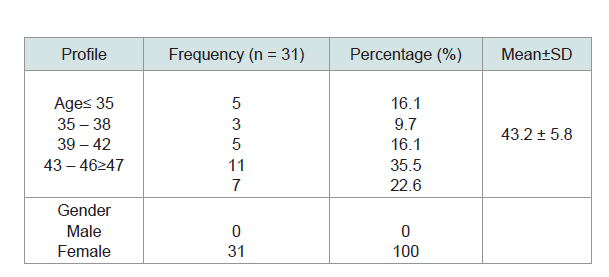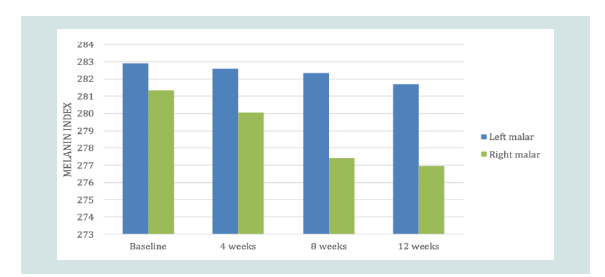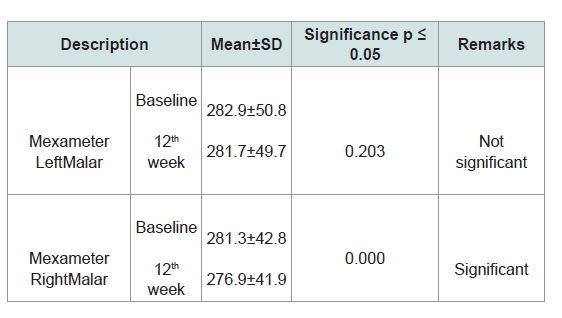Journal of Clinical and Investigative Dermatology
Download PDF
Research Article
A Pilot Study on Aloe Vera Leaf Extract in Cream Base for the Clinical Improvement of Melasma: A Split-Face Trial
Vanika Celina Y. Viardo1* and Lillian L. Villafuerte2
1Department of Dermatology, Unihealth Paranaque Hospital, Philippines
2Department of Dermatology, Jose R. Reyes Memorial Medical Center, Philippines
*Address for Correspondence: Vanika Celina Y. Viardo, Dermatologist Diplomate, Philippine
Dermatological Society, Unihealth Paranaque Hospital, Philippines,
Email: vanikaviardomd@gmail.com
Submission: 11 MArch, 2020;
Accepted: 18 April, 2020;
Published: 21 April, 2020
Copyright: © 2020 Celina Y, et al. This is an open access article distributed
under the Creative Commons Attribution License, which permits unrestricted
use, distribution, and reproduction in any medium, provided the original work
is properly cited.
Abstract
Introduction: Melasma is a pigmentary disorder, generally difficult to treat,
hence, the need for skin lightening agents. Recent studies found out that aloesin, a
component of the aloe vera leaft extract, has a therapeutic effect on pigmentation
suppression via its inhibitory effect on the tyrosinase activity.Based on these
findings, aloe vera leaf extract may be used as an alternative treatment for melasma.
Objectives: The general objective of the study is to determine the efficacy
and safety of aloe vera leaf extract in cream base for the clinical improvement
of melasma among patients seen in Jose R. Reyes Memorial Medical Center,
Dermatology Department, OPD
Methods: 35 patients (Fitzpatrick skin types III-V) diagnosed with epidermal
or mixed type of melasma were given aloe vera extract in cream base to be applied
over the hyperpigmented patches on the right malar area once a day. Similar
cleansing soap and sunblock were given to the patients. Patient’s hyperpigmented
patches, both treated and untreated, were evaluated at baseline and every 4 weeks
using the Mexameter. This procedure was done for a period of 12 weeks.
Results: Based on the target of thirty five (35) subjects, this study came up
with thirty one (31) respondents due to non-follow up of 4 patients. Skin melanin
index on the right malar, as measured by a mexameter, decreased continuously and
this reduction in pigmentation was statistically significant at 12 weeks of treatment
(p=0.000). There was no incidence of adverse effects reported with the topical use
of aloevera extract in cream base.
Conclusion: Aloe Vera Leaf Extract in cream base is an effective and safe
alternative treatment option for the clinical improvement of melasma.
Introduction
Melasma is a common acquired disorder characterized by
symmetric, hyperpigmented patches especially on the forehead,
malar regions and upper lip [1]. Although the exact pathogenesis
of melasma is unknown, it is hypothesized that following exposure
to UV irradiation, hyperfunctional melanocytes within involved
skin produce increase amounts of melanin. Additional important
pathogenic factors include the skin phototype and estrogens and
disorders such as autoimmune thyroid disease also have the potential
to aggravate melasma [2].
Melasma is a very common cutaneous disorder, accounting for
0.25 to 4% of the patients seen in Dermatology Clinics in South East
Asia [3]. It is most prevalent among young to middle-aged women
who are Hispanic or of African, Asian or Middle Eastern descent
[4]. By causing cosmetic disfigurement, melasma is an aesthetically
undesirable, skin condition which is frequently associated with a
significant emotional effect.Pigmentary disorders including melasma
are generally difficult to treat, hence, the need for skin lightening
agents including cosmeceuticals. Common topical agents currently
used to treat hyperpigmentation include hydroquinone, retinoids, glycolic acid and azelaic acid. However, these compounds can cause
adverse effects, mostly in the form of skin irritation. In addition,
hydroquinone, a very effective depigmenting agent which acts
via inhibiting the conversion of DOPA to melanin by inhibition
of the enzyme, tyrosinase, can rarely produce an untoward skin
pigmentation called exogenous ochronosis [5]. Many patients,
therefore, do not tolerate such depigmenting ingredient and request
milder yet efficacious compounds. Both patients and physicians are
increasingly welcoming the use of depigmenting agents from natural
sources in view of their high efficacy and tolerance.
In the search for novel depigmenting agents, the investigation of
natural plant extracts has led to the identification of many potentially
active compounds. Several studies were done to assess the medicinal
properties of aloevera and results have raised the possibility that
aloesin, a chromone derivative isolated from aloevera leaf, may
be used as an agent to inhibit melanin formation induced by UV
radiation by inhibiting tyrosinase activity [6-8].
We report herein a pilot study on the efficacy and safety of
aloe vera leaf extract in cream base for the clinical improvement of
melasma among Filipinos seen at the Department of Dermatology of
the Jose R. Reyes Memorial Medical Center.
Patients and Methods
Study Design:
This was a split-face, pilot study conductedin the Dermatology
Outpatient Department of Jose R. Reyes Memorial Medical Center.An Institutional Review Board / Institutional Ethics Committee
of the Jose R. Reyes Memorial Medical Center approved the study
prior to its initiation following the guidelines of good clinical practice.
Patients:
Male or female aged 18-50 years with skin type III-V, diagnosed
with epidermal or mixed type of melasma clinically and classified
by Wood’s lamp examination were enrolled, after signing a written informed consent form.Pregnant women or nursing mothers using oral contraceptive pills
or any cosmetic depigmenting agents (such as Hydroquinone) within
6 months prior to the study, those with known hypersensitivity to
any of the components of the test medication, or with any significant
medical condition or history of chronic systemic disorders were
excluded. Volunteers were also excluded if they were expected to have
any prolonged exposure to the sun during the study.
Product:
The aloe vera leaf extract in cream form was prepared by the
University of the Philippines-Manila, College of Pharmacy, Industrial
Pharmacy Unit.Intervention:
Patient fulfilling inclusion and exclusion criteria were instructed
to wash their skin with mild cleanser and to apply the same brand
of broad spectrum sunscreen with SPF 50 on the entire face every
morning. The aloe vera extract in cream base was applied on the right
malar area only, once a day, before bedtime for 12 weeks.Clinical Assessment:
Patient’s hyperpigmented patches on the malar area, both treated
and untreated, were evaluated at baseline and every 4 weeks using the
Mexameter.Safety Assessment:
To evaluate the tolerability of the test cream, the subjects were
asked to record any dryness, itching, stinging, redness, or scaling
during the treatment period. In case of any severe adverse effects and
if the participant could not continue the study, the use of cream was
stopped and the measurements were done on the same or next day.Statistical Analysis:
Statistical analyses were performed using IBM SPSS (version 21;
SPSS Inc., Chicago, IL USA) software considering 95% confidence
interval in statistical data analyses. For the descriptive analysis, means
with their corresponding standard deviation was used to describe the
demographic characteristics of all the patients included in the study
while proportion wasused for the categorical data.Melanin indexof
the right and left malar area were presented as the mean±standard
deviation. Values obtained at week 12 were compared with baseline
values using paired t-test and the statistical significance was set at a
p-value less than 0.05 An incidence proportion was used to determine
and record the incidence of adverse effects with the topical use of aloe vera extract in cream base.Results
Based on the target of thirty five (35) subjects, this study came
up to thirty one (31) respondents due to non-follow up of 4 patients.
The collected data on age and gender were tabulated and presented in
frequency and percentage as shown in Table 1. It was revealed that all
patients were female and no male voluntarily gave their consent for
the study. The average age of patients was 43.2 years (SD = 5.8). The
results implied that the patients’ ages were significantly distributed
in 31 to 51 age range interval but majority of the patients plunged in
age intervals of 43 to 46 years old. The melanin index was monitored
by Mexameter at baseline and after intervention at weeks 4, 8 and 12.
The average level of melanin index showed a continuous reduction
(Figure 1) for both the treated and the untreated areas. The reduction
in melanin index for the right malar was statistically significant at
week 12 (p=0.00).
(Table 2). There were no adverse effects such as erythema,
pruritus, or burning noted throughout the course of treatment.
Discussion
Melasma is a very common cutaneous disorder more frequently
observed among women, accounting for 90% of cases [9]. Pigmentation
disorders such as melasma, can be an issue for all individuals,
especially those with skin of color [10]. Treatment of melasma is
difficult and a number of agents have been used for this intractable
condition. Hydroquinone, the gold standard in the treatment of
hyper pigmentation for more than 50 years, is a phenoliccompound
that reduces the conversion of dihydroxyphenylalanine to melanin by
inhibiting tyrosinase [11]. However, concerns regarding ochronosis,
allergic and irritant contact dermatitis, and melanocyte toxicity have prompted a search to find alternative agents for the topical
management of melasma. Aloe vera is the oldest medicinal plant ever
known and has been used externally to treat various dermatological
conditions due to its anti-inflammatory, anti-bacterial, anti-fungal
and anti-oxidant properties [5]. Increases in the use of aloe vera
leaf extract as a skin cosmetic prompted Yagi et al.to identify the
active components and reported that barbaloin, 2’-o-feruloylaloesin,
aloenin, and aloesin inhibit mushroom tyrosinase activity in vitro,
aloesin showed higher activity than the others [7]. On the basis of
these results, Choi et al. examined the inhibitory effect of aloesin on
the pigmentation of human skin induced by UV radiation and found
out that aloesin inhibit hyperpigmentation after UV radiation in a
dose dependent manner and concluded that aloesin has a therapeutic
effect on pigmentation suppression via its inhibitory effect on the
tyrosinase activity [7].
In this study,it was assessed that both the right and left malar areas
showed a continuous decrease in pigmentation for the treatment
duration of 12 weeks. This reduction was observed as early as 4 weeks
of treatment (Figure 1). The result of the t-test comparing the values
taken at baseline and at 12 weeks of treatment showed a significant
reduction in pigmentation for the right malar area (Table 2) and this
result further suggeststhe effectivity of using aloe vera leaf extract in
cream base for the clinical improvement of melasma.
Although the decrease in the melanin index for the left malar area
was not significant (Table 2), this decrease highlights the importance
of sunblock in the treatment armamentarium of melasma patients
and the use of it alone, may not just control or prevent worsening of
melasma but also adequate to cause a mild clinicalimprovement. In
a study using pigmented skin equivalents (human keratinocytes and
fibroblasts), aloesin induced dose-dependent reduction in tyrosinase
activity and melanin content without changing the morphology of
the cells, suggesting a good safety profile [11]. This pilot study further
demonstrates the safety of topical application of aloe vera leaf extract
in cream base which did not show incidence of adverse effects.
One limitation of this study was the lack of long-term follow-up
of the subjects after the end of the trial. Also, it is recommended to
assess the patient’s quality-of-life as well as to do a subjective measure
of improvement in addition to the objective parameter.
Conclusion
In conclusion, the result of this pilot study suggests that Aloe
Vera Leaf Extract in cream base is an effective and safe alternative
treatment option for the clinical improvement of melasma. Larger
randomized, controlled trials are needed to further establish its
efficacy and safety.




